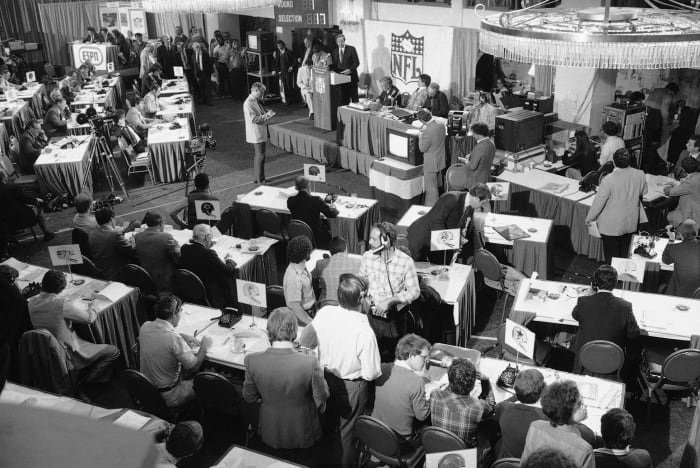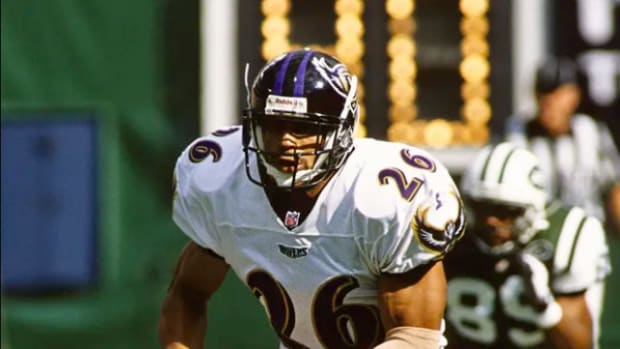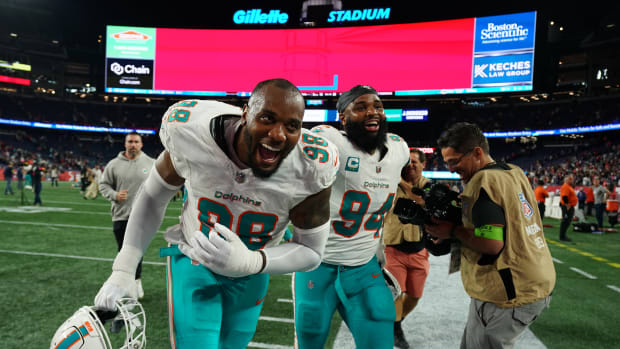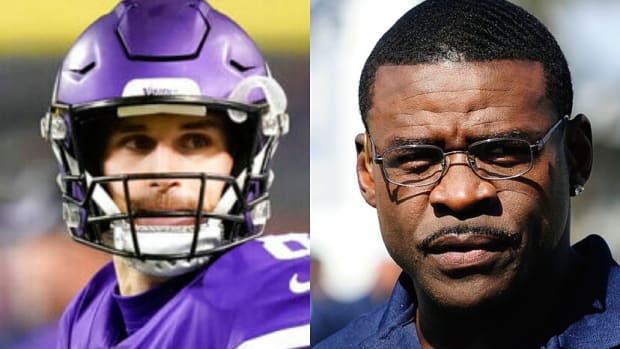A Bold New Network, a Preposterous Idea: How the NFL Draft Came to TV
You want to televise what?
Pete Rozelle was befuddled after fielding an unusual request from a fledgling sports network. It was an inquiry about broadcasting the NFL’s “annual player selection meeting”—or, as it’s better known, the draft.
Rozelle wasn’t the only skeptic. “There’s nobody there,” Bill Fitts, a producer at the time, told his boss. “It’s just a bunch of people on the phone. And they’re not even ‘name’ people—they’re nobody. It’s just a room with some people on the phone.”
But Chet Simmons, then the president of the Entertainment and Sports Programming Network, envisioned the New York City ballroom where league officials presided and team officials sat at their respective tables. He saw the potential for something more, or, at least a reason to give the idea a try.
“It’s the NFL,” he told Fitts.
The NFL draft has become one of the biggest annual sporting events on the television calendar. Last year’s edition drew hundreds of thousands of fans to its Nashville set, but this year it will be a “virtual draft” due to the coronavirus pandemic. That should make for a surreal broadcast when both ESPN and NFL Network go live with the first round on April 23. But it won’t be as weird as the broadcast that aired the morning of April 29, 1980, when the idea of putting the NFL draft on live TV was nothing short of preposterous.
* * *
When ESPN approached the NFL, the network had been on the air for about six months, since September 1979. Simmons had Chris Berman and Bob Ley at the time, but little else—certainly no programming from the major sports leagues. The station’s airwaves were filled with exercise shows, Australian rules football, slow-pitch softball and the like. But the network was an ambitious startup and no idea was too outrageous, so in February 1980, two months before the draft would take place, Simmons, a veteran TV sports executive, threw out the idea of broadcasting it. Rozelle took ESPN’s request to the 28 NFL owners; they overwhelmingly rejected it.
“There was absolute unanimity in all the ownership that they did not want this to happen,” recalls Jim Steeg, the NFL’s VP of special events at the time. “They were afraid that the agents would dominate the draft, so they said no.”
The commissioner, however, had no intention of denying ESPN. There are several reasons Rozelle is considered one of the all-time great commissioners in any sport. Many of those reasons relate to television and the importance he placed on the medium. Rozelle brokered the league’s first major TV deals in the ’60s. He championed NFL Films. He partnered with television legend Roone Arledge to come up with the wild idea to televise football games on a weeknight.
So, 10 years after the birth of Monday Night Football, Rozelle was ready to champion another out-of-the-box idea. He didn’t care that the owners had just told him no.
Recalls Steeg: “Pete walked out of that room and turned to me and said, ‘Call Chet Simmons and tell him that he’s gonna do the draft as a news event. And we can’t stop him from covering it.”
Fitts would be the producer for ESPN’s live draft coverage. He and his team immediately began calling NFL scouts and general managers to pick their brains about team needs and top prospects. He called colleges around the country asking for any footage they had of these players. College football on ESPN didn’t exist at the time, so it’s not like they had anything in the can.
The owners’ fear of agents getting involved was legit: Agents were among the first people Fitts called to get information on college prospects. For better or worse, there just weren’t too many other sources of draft information out there at the time.
One of Fitts’s production assistants called Howard Balzer, who at the time was the NFL editor at The Sporting News in St. Louis. The venerable weekly publication was one of the only places one might find a mock draft. Balzer remembers getting the call about three weeks before the draft. ESPN requested permission to use The Sporting News’ mock on the broadcast.
“I said, ‘Yeah, sure, we have no problem allowing you to do that,’ ” says Balzer. “But the issue with that is that those mock drafts can get shot to hell pretty quick.” Because of print deadlines, Balzer explained that the mock draft would probably be written almost two full weeks before the actual draft.
“It doesn’t reflect any last-minute info,” Balzer told them. “So I said, ‘Look, I do local radio in St. Louis. Maybe it would make sense to have me on a phone hookup and at different times you can go to me, whenever you feel it’s necessary.’”
The network was intrigued by the idea. Balzer doesn’t remember whether it was later that same day or perhaps the next day, but he did get the callback, with a slightly different request: “Would you like to come to Bristol and be on the draft telecast?”
Balzer ended up being part of ESPN’s draft broadcast for the first nine years. For that inaugural 1980 broadcast, he was in ESPN’s modest Bristol, Conn., studio. A year later, he was part of the coverage in New York (along with Sports Illustrated’s Paul Zimmerman). In later years, he would report from different team headquarters.
At the time, ESPN’s signal reached a total of four million homes (it now reaches more than 200 million); it’s not as if a ton of people saw the Lions make Oklahoma’s Billy Sims the No. 1 pick. One week before the draft, ESPN put out a press release announcing its coverage plans: “This will mark the first time the NFL draft of collegians has ever received such complete live coverage which ESPN will present to its affiliates nationwide via RCA's Satcom I, Transponder #7.”
The live coverage was split between Bristol and a small desk setup outside a ballroom of the New York Sheraton, where the draft was taking place. Coverage featured anchor Ley in studio with Balzer; Upton Bell, who had been general manager of the Baltimore Colts and New England Patriots; and former Eagles player Vince Papale (that’s right, the Philly bartender whose brief NFL career was chronicled in the film Invincible). In New York, ESPN deployed former Colts and 49ers general manager Joe Thomas and a team of four reporters that included George Grande. (It was Grande who appeared at the SportsCenter desk when ESPN first went on the air on Sept. 7, 1979.) Ultimately, the NFL was happy with the broadcast. It was the start of a promising relationship.
“It was a big deal for ESPN because it gave them an association with the National Football League,” says Fred Gaudelli, the producer of NBC’s Sunday Night Football who was part of ESPN’s draft broadcasts for 22 years. “And it was certainly a benchmark for ESPN. By doing the job that we did with the draft back then, it proved to the league that we were real. So when [the NFL] created a cable package in 1987, we were well positioned to get it. That was a big deal for ESPN. You can’t really understate how big a deal that was.”
* * *
While ESPN was televising the 1980 draft, the Baltimore Colts were hosting a draft day party for hundreds of fans at the Baltimore Convention Center. One of the guests the team brought to the party was a teenager from Baltimore who, one year earlier, had started publishing his own draft preview guide.
Mel Kiper Jr. was 19 years old and believed in the work he was doing, especially as he was encouraged by his good friend, then Colts assistant general manager Ernie Accorsi. Kiper saw only some of the 1980 draft on TV—he was busy at the convention center and with radio obligations—but he recognized ESPN’s coverage as validation for his own work.
“My feeling was, there’s got to be a market for this,” Kiper says. “When I saw it televised, I said, ‘O.K., now everybody’s seen this process, they’re feeling it.’
“Back then you only had two college games televised every Saturday, so you didn’t have any access to this stuff. Certainly they had no access to the small-college kids. So after they were drafted it was a vehicle to get this information out to the fans. I thought there would be a great interest in the draft for that reason. I believed what ESPN was doing was gonna pop and be huge.”
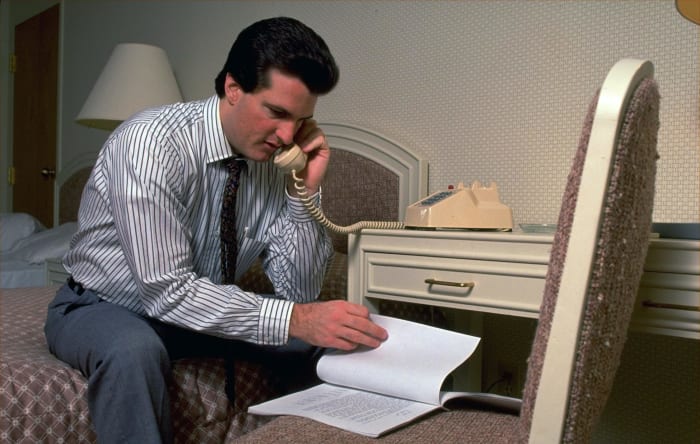
Kiper wasn't a part of the first draft telecast, but he joined ESPN in 1984 and, by 1992, was being profiled in Sports Illustrated.
John Biever/Sports Illustrated
Kiper didn’t join the ESPN broadcast until 1984. He might never have joined were it not for the Colts’ tumultuous escape from Baltimore.
It was the spring of 1983, just weeks after the Colts had selected John Elway first and then traded him to Denver. Accorsi, now the Colts’ general manager, offered Kiper a front-office job with the team. Kiper, who grew up a die-hard Colts fan, jumped at it. Before he could start, however, he got bad news.
“I can’t bring you in right now,” Accorsi told him. “I’m probably not going to be here much longer myself. It’s just not a good scenario.” The GM told Kiper to stick with the draft guides.
“He said, ‘You have the potential for a really good business here. Just keep doing what you’re doing,’ ” Kiper says. “And I did.”
Accorsi resigned from the Colts at the end of the 1983 season. On March 28, 1984, the Colts packed up and moved to Indianapolis. About a month earlier, Fitts was in Bristol preparing for the 1984 draft. An agent had told him about Kiper’s draft guides. Fitts brought him in for research help, then had him tape a few segments. Kiper impressed.
“The single greatest thing that ESPN did for itself as it relates to the NFL draft was hire Mel Kiper,” says Gaudelli. “Because he became a go-to guy, not only for us but for all the media and all the fans.”
Kiper’s TV presence improved year by year, as did the overall production of the draft. Folks at NFL headquarters were certainly recognizing the growth in popularity of the draft. And they were pleased that ESPN’s intrusion into the league’s previously private event never really became that.
“The procedure didn’t really change,” says former NFL executive Joel Bussert, who oversaw operations at the draft for decades. There were times the league had to delay announcing a pick until ESPN came back from commercial, but for the most part everything ran smoothly.
One thing Bussert noticed was that the draft took much longer than it did before it was on TV. The presumption has always been that teams will use all the time they are allotted in case they get a last-second trade offer. Bussert has a different take.
“Some of the teams admitted to me that they sort of enjoyed being on the clock,” he says. “The attention that it got. Our clubs were milking their TV time for all it was worth.”
* * *

After the Lions selected him with the first overall pick, Billy Sims (left) sat down with ESPN's George Grande (center) and Joe Thomas (right), the former Baltimore Colts GM.
Courtesy of ESPN
Kiper was in the Bristol studio, not on site in New York, for his first draft with ESPN. The other big difference between now and then: The draft began on a Tuesday. It took two days, and ESPN’s coverage did not extend into Wednesday. “We signed off midway through the second round,” Kiper recalls.
The NFL moved the draft from Tuesday-Wednesday to Sunday-Monday in 1988, but it wasn’t until 1993 that ESPN was on the air for every single pick of the draft. By then, the draft broadcast was a major production. In addition to Kiper and crew on the set in New York, ESPN had cameras all over the country.
“I think what is synonymous with ESPN in its growth is that when we get involved in a project we look at it in all levels, 360 degrees to try to find out what are unique ways to tell that story and to be a part of it,” says coordinating director Chip Dean, who worked his first draft in 1983 and then directed ESPN’s draft coverage for 20 years. “When we first got into it, it was all about analyzing the players. Then we realized we had to have more coverage—going into kids’ living rooms, into team headquarters. So we just started expanding.”
Dean says many ESPN staffers who work on the draft today are at it for nearly six months, a huge operation that he compares to the preparation a network might put in for Olympics coverage. “It’s that big of a project,” he says. “It’s just massive.”
In 1980, Fitts and his crew were proud of the fact they had video packages prepared for 27 of the 28 first-round picks. These days, they have a package ready to go for every pick of every round. In 2019, that meant packages for 254 players drafted—not to mention many more that were ready to go for players who never got drafted.
When Gaudelli became producer of the draft in 1990, the NFL would invite two or three top prospects to the event. However, ESPN couldn’t put them on camera until after they were drafted. That’s when Gaudelli started setting up shoots with kids at their homes—and it became a feeding frenzy for agents looking to get exposure for their new clients.
“Once the NFL saw the agents fighting to get their players on TV,” says Gaudelli, “that’s when the league started inviting as many players as possible and lifting the restrictions that ESPN couldn’t speak to them before they were drafted.” The league invited more prospects every year—there were 23 at the 2019 draft.
Last spring, Nashville marked the fourth year in a row that the league has held the draft in a different city, following Chicago, Philadelphia and Dallas. If not for the pandemic, Las Vegas, the NFL’s newest home, would have hosted this year’s edition. Because, just like they do for Super Bowls, cities now bid for the right to host the draft. That comes with droves of fans, bright lights and prospects who are celebrities before anyone knows which team they’ll be joining. And it all grew out of that vision, 40 years ago, for a room with some people on the phone.
Craig Ellenport is a veteran NFL writer and author of NFL100: The Greatest Moments of the NFL's Century (Triumph Books).
• Question or comment? Email us.
































